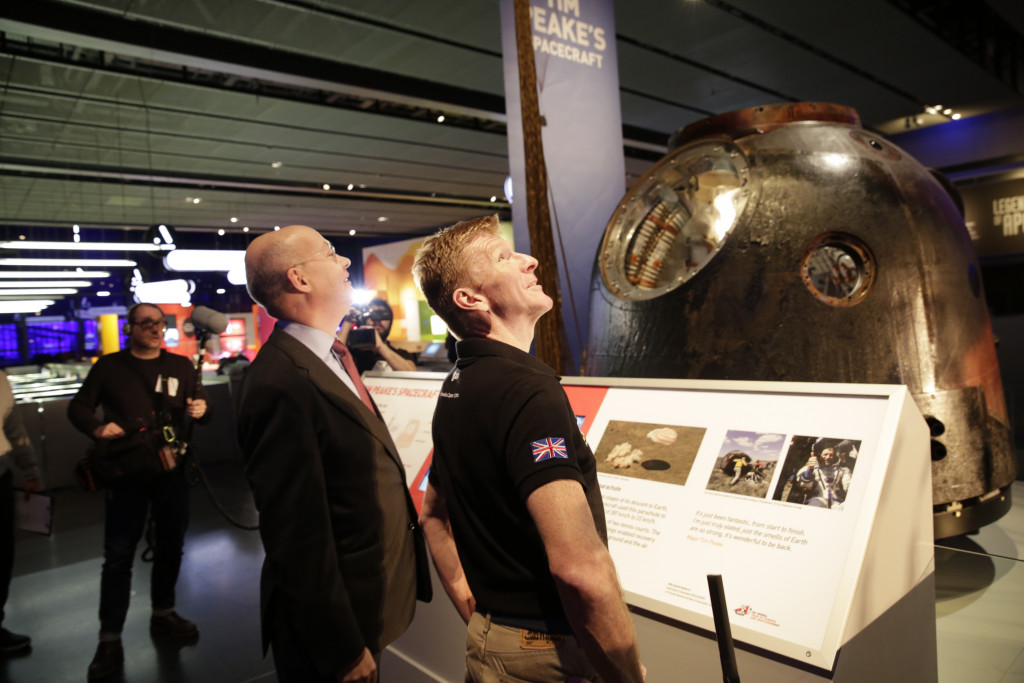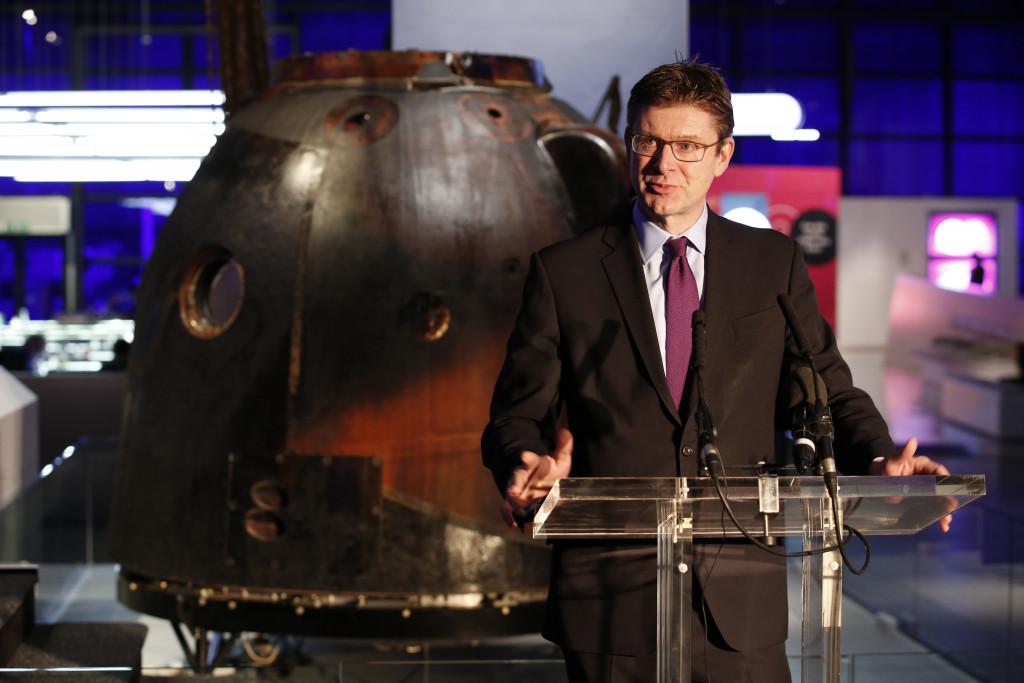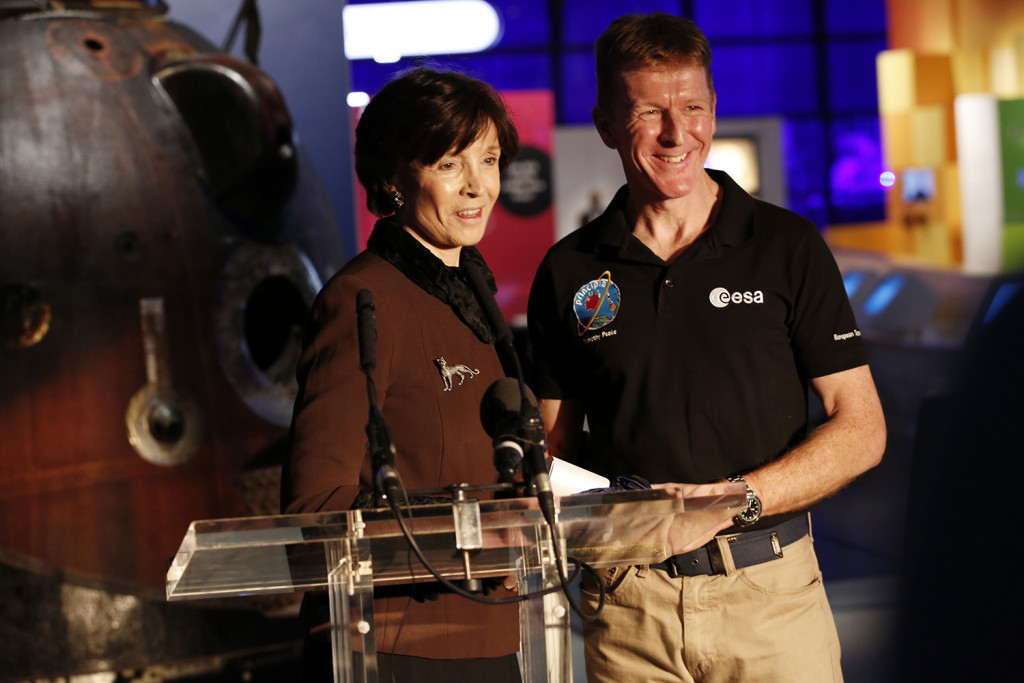A second visit to the International Space Station for British astronaut Tim Peake, along with a virtual reality experience to capture the thrills of his first mission, were announced today at the Science Museum.
Peake was reunited with the Soyuz TMA 19M spacecraft that took him safely into orbit and back to Earth again for his Principia Mission, after it was acquired by the Science Museum Group to help inspire the next generation of space-farers to Mars and beyond.
Ian Blatchford, Director of the Group, said that ‘today is a great occasion for the Science Museum’, marking the first space-flown object in its collection and its first Russian technology too, a ‘great symbol of the very strong friendship between this museum and our many colleagues in the Russian space industry.’
Peake, the UK’s first European Space Agency astronaut, stood before his Soyuz, which now bears the scorch marks of its 1600 degrees C descent, in the museum’s Wellcome Wing, and said that he ‘always gets such enormous pleasure from my visits to the Science Museum’.
On being reunited with the craft that took him to space and back again, he remarked: ‘I’m quite fond of this spacecraft. We go back a bit.’

He reminisced about first seeing the capsule tightly packed with cargo before launch which was ‘one of the few times I have been grateful to be only five foot eight’, and then how he looked on in awe when it sat atop 300 tons of rocket fuel on the launch pad.
Orbiting in the ISS, Peake had watched a video of the launch party in December 2015 at the Science Museum, when he wished he had been celebrating too with the 3000 schoolchildren who had counted down his lift off.
Peake hoped that his spacecraft would remind us how science pushes the boundary of what is possible, and inspire the next generation, sharing the news with his followers on Facebook and on Twitter, where the Museum trended.
His main parachute, which helped cushion his descent to the steppes of Kazakhstan, now hangs above the capsule, and the Museum is also working on a virtual reality experience with the company Alchemy VR.
From March, those who come to see his capsule will be able to experience what he felt inside his Soyuz descent module when it returned to Earth at speeds of over 27,000kph.
Peake commented that the VR ‘really is breath-taking – and that comes from someone who has spent an awful lot of time using VR systems while training for my first mission. Science Museum visitors are going to experience something that truly is very close to the real thing.’
Among the audience of dignitaries, photographers and press was Helen Sharman, who became the first Briton in space in 1991, the Emmy- and Bafta- award winner Anthony Geffen, who founded Alchemy VR, and museum Trustee Lord Willetts, who in 2013, as the then UK science minister, paved the way for UK manned missions.
Greg Clark, Secretary of State for Business, Energy and Industrial Strategy also announced in the museum that Peake would be returning to space for a second mission to carry out scientific research on the International Space Station, ‘ another real breakthrough.’

The Secretary of State emphasised how the UK needs to invest in scientific, engineering and mathematical skills, highlighted the Government’s industrial strategy and investment, and pointed out that the space sector contributes £13 billion to the UK economy,
He admitted to being in awe of the capsule to which Tim Peake entrusted his life, which has ‘74,000,000 miles on the clock’, and highlighted the role of his mission in conveying the wonder, excitement and promise of space.
Mr Clark underlined this by saying that if there is any place that British science feels at home, ‘it is certainly in this wonderful museum…with more than three million visitors each year, it is a powerful instrument of scientific education and inspiration.’
The minister also praised the UK Space Agency and international partners.
Johann-Dietrich Wörner, Director General of the European Space Agency, told the audience via video link that cooperation ‘beyond earthly borders’ was ‘very important’ and emphasised the point by showing a picture of Peake with his Soyuz crewmates, Russian Yuri Malenchenko and American Tim Kopra, before their launch. ‘Space can bridge earthly problems.’
The Director General also joked about Peake’s ‘soft landing’ after a re-entry in which g forces reached more than five times Earth’s gravity, explaining that it meant braking ‘with the soft parts of your body’ when the craft crunched down and tumbled after its retrorockets had fired.
The President of the company which made Peake’s Soyuz, Vladimir Lvovich Solntsev, talked of the good relationships with the Science Museum, as a result of its pioneering Cosmonauts exhibition, which attracted 70,000 visitors when it transferred to Pavilion No. 1 (Central) at VDNH in Moscow. He hoped more Russian technology would end up in the Science Museum.
The romance and heroism of space exploration was recounted by Deputy Minister of Science and Education of the Russian Federation, Veniamin Kaganov, starting with the launch of Yuri Gagarin. He recalled how ‘we all looked up to cosmonauts.’
The minister praised the efforts of the Science Museum in helping to provide ‘a living imprint’ in the minds of young people with its exhibitions and events, and referred to how a UK-Russian year of science will be launched tomorrow in Moscow, including a Science Museum tribute to the first civilian and first woman in space, Valentina Tereshkova.
Dame Mary Archer, Chair of the Science Museum Group Board of Trustees, told Tim Peake that ‘the UK, ESA, indeed the whole space community is so lucky to have you as ambassador” as she awarded him a Fellowship of the museum for inspiring millions with his mission.

‘As you left Earth, strapped inside this little craft, I was fortunate enough to be here at the museum engulfed by 3000 excited girls and boys whose imaginations were firing like mini-Soyuz rockets.’
Among the throng were astronauts Helen Sharman, Chris Hadfield and Andreas Mogensen and pioneering spacewalker, Alexei Leonov. Dame Mary recalled how Leonov shouted “Good luck Tim” and added: ‘I think I saw a tear in his eye.’
Peake joins a select group from Stephen Hawking to Her Majesty The Queen – including three other space farers Valentina Tereshkova, Leonev and Helen Sharman. Peake responded by saying it was a ‘huge honour’ and said he looked forward to working with the museum in the future to encourage the next generation.
Today’s news was covered with live broadcasts on BBC News (broadcast and online), BBC Breakfast, BBC Two, ITV News, Sky News (broadcast and online), local radio, Wired UK, Evening Standard, The Mirror, The Independent, The Telegraph, Gizmodo, International Business Times, epa.eu, Newsround, Daily Mail, The Guardian, Reuters, Ars Technica and The Times.
The museum has run a number of space events over the past year: an in conversation event with Buzz Aldrin and Brian Cox; Helen Sharman’s silver anniversary; a space fashion show – #coutureinorbit – with the European Space Agency, sponsored by Bionic Yarn; Oscar-winning director Alfonso Cuarón, who discussed his space thriller Gravity; and a Royal Society event on the future of human space exploration.